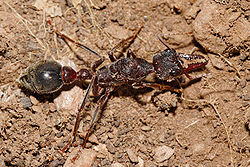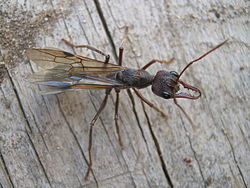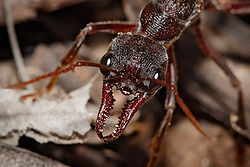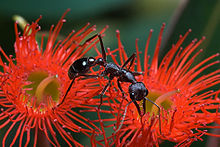- Myrmecia
-
Myrmecia 
Bull Ant Scientific classification Kingdom: Animalia Phylum: Arthropoda Subphylum: Hexapoda Class: Insecta Order: Hymenoptera Suborder: Apocrita Superfamily: Vespoidea Family: Formicidae Subfamily: Myrmeciinae Genus: Myrmecia
Fabricius, 1804Species Myrmecia forficata
Myrmecia gulosa
Myrmecia inquilina
Myrmecia pilosula
many more, see textDiversity c. 90 species Myrmecia, often called bulldog ants, bull ants, inch ants, sergeant ants, jumper ants or jack-jumpers (although jack jumper only applies to members of the M. pilosula species group), is a genus of ants. Bull ants can grow to over 40 mm (1.6 in) in length, with the smallest species 15 mm (0.59 in) long. Almost all of the approximately 90 species are endemic to Australia, with the single exception of Myrmecia apicalis from New Caledonia, where it is rare.[1]
Contents
Biology
These ants are well-known in Australia for their aggressive behaviour and powerful stings.[1] The venom of these ants has the potential to induce anaphylactic shock in allergic sting victims. As with most severe allergic reactions, if left untreated the reaction may be lethal. These large, alert ants have characteristic large eyes and long, slender mandibles. They have superior vision, able to track and even follow intruders from a distance of 1 metre.[1] Myrmecia is one of several ant genera which possess gamergates, female worker ants which are able to mate and reproduce, thus sustaining the colony after the loss of the queen. A colony of Myrmecia pyriformis without queen was collected in 1998 and kept in captivity, during which time the gamergates produced viable workers for three years.[2]
Diet
Bull ants eat small insects, honeydew (a sweet, sticky liquid found on leaves, deposited from various insects), seeds, fruit, fungi, gums, and nectar. The adult ants mainly eat nectar and honeydew, but the ant larvae are carnivores that eat small insects brought back to them by hunting worker ants. The workers can also regurgitate food back in the nest so other ants can consume it.
Foes of bull ants are the black ants, which despite being much smaller, use their much greater numbers to overwhelm bull ant colonies.
Philosophy
The bull ant famously appears in the philosopher Arthur Schopenhauer's major work, The World as Will and Representation, as a paradigmatic example of strife and constant destruction endemic to the "will to live".
"But the bulldog-ant of Australia affords us the most extraordinary example of this kind; for if it is cut in two, a battle begins between the head and the tail. The head seizes the tail in its teeth, and the tail defends itself bravely by stinging the head: the battle may last for half an hour, until they die or are dragged away by other ants. This contest takes place every time the experiment is tried." [3]
Species
- Myrmecia aberrans Forel, 1900
- Myrmecia acuta Ogata & Taylor, 1991
- Myrmecia analis Mayr, 1862
- Myrmecia apicalis Emery, 1883
- Myrmecia arnoldi Clark, 1951
- Myrmecia athertonensis Forel, 1915
- Myrmecia auriventris Mayr, 1870
- Myrmecia borealis Ogata & Taylor, 1991
- Myrmecia brevinoda Forel, 1910
- Myrmecia browningi Ogata & Taylor, 1991
- Myrmecia callima (Clark, 1943)
- Myrmecia cephalotes (Clark, 1943)
- Myrmecia chasei Forel, 1894
- Myrmecia chrysogaster (Clark, 1943)
- Myrmecia clarki Crawley, 1922
- Myrmecia comata Clark, 1951
- Myrmecia croslandi Taylor, 1991
- Myrmecia cydista (Clark, 1943)
- Myrmecia desertorum Wheeler, 1915
- Myrmecia dichospila Clark, 1938
- Myrmecia dimidiata Clark, 1951
- Myrmecia dispar (Clark, 1951)
- Myrmecia elegans (Clark, 1943)
- Myrmecia erecta Ogata & Taylor, 1991
- Myrmecia esuriens Fabricius, 1804
- Myrmecia eungellensis Ogata & Taylor, 1991
- Myrmecia exigua (Clark, 1943)
- Myrmecia fabricii Ogata & Taylor, 1991
- Myrmecia ferruginea Mayr, 1876
- Myrmecia flammicollis Brown, 1953
- Myrmecia flavicoma Roger, 1861
- Myrmecia forceps Roger, 1861
- Myrmecia forficata (Fabricius, 1787)
- Myrmecia formosa Wheeler, 1933
- Myrmecia froggatti Forel, 1910
- Myrmecia fucosa Clark, 1934
- Myrmecia fulgida Clark, 1951
- Myrmecia fulviculis Forel, 1913
- Myrmecia fulvipes Roger, 1861
- Myrmecia fuscipes Clark, 1951
- Myrmecia gilberti Forel, 1910
- Myrmecia gratiosa Clark, 1951
- Myrmecia gulosa (Fabricius, 1775)
- Myrmecia harderi Forel, 1910
- Myrmecia hilli (Clark, 1943)
- Myrmecia hirsuta Clark, 1951
- Myrmecia infima Forel, 1900
- Myrmecia inquilina Douglas & Brown, 1959
- Myrmecia loweryi Ogata & Taylor, 1991
- Myrmecia ludlowi Crawley, 1922
- Myrmecia luteiforceps Wheeler, 1933
- Myrmecia mandibularis Smith, 1858
- Myrmecia maura Wheeler, 1933
- Myrmecia maxima Moore, 1842
- Myrmecia michaelseni Forel, 1907
- Myrmecia midas Clark, 1951
- Myrmecia minuscula Forel, 1915
- Myrmecia mjobergi Forel, 1915
- Myrmecia nigra Forel, 1907
- Myrmecia nigriceps Mayr, 1862
- Myrmecia nigriscapa Roger, 1861
- Myrmecia nigrocincta Smith, 1858
- Myrmecia nobilis (Clark, 1943)
- Myrmecia occidentalis (Clark, 1943)
- Myrmecia pavida Clark, 1951
- Myrmecia petiolata Emery, 1895
- Myrmecia picta Smith, 1858
- Myrmecia picticeps Clark, 1951
- Myrmecia piliventris Smith, 1858
- Myrmecia pilosula Smith, 1858
- Myrmecia potteri (Clark, 1951)
- Myrmecia pulchra Clark, 1929
- Myrmecia pyriformis Smith, 1858
- Myrmecia queenslandica Forel, 1915
- Myrmecia regularis Crawley, 1925
- Myrmecia rowlandi Forel, 1910
- Myrmecia rubicunda (Clark, 1943)
- Myrmecia rubripes Clark, 1951
- Myrmecia rufinodis Smith, 1858
- Myrmecia rugosa Wheeler, 1933
- Myrmecia simillima Smith, 1858
- Myrmecia subfasciata Viehmeyer, 1924
- Myrmecia swalei Crawley, 1922
- Myrmecia tarsata Smith, 1858
- Myrmecia tepperi Emery, 1898
- Myrmecia testaceipes (Clark, 1943)
- Myrmecia tridentata Ogata & Taylor, 1991
- Myrmecia urens Lowne, 1865
- Myrmecia varians Mayr, 1876
- Myrmecia vindex Smith, 1858
References
- ^ a b c Ants Down Under
- ^ Dietemann V., Peeters, C, & Hölldobler, B. 2004 "Gamergates in the Australian ant subfamily Myrmeciinae" Naturwissenschaften 91(9):432-435
- ^ The World as Will and Representation
- Bugs take the squeeze to breathe easy
- Ants
- Red Bull ant
- [1]
- ITIS: Genus Myrmecia
- Ants Down Under: Genus Myrmecia
External links
Categories:
Wikimedia Foundation. 2010.





